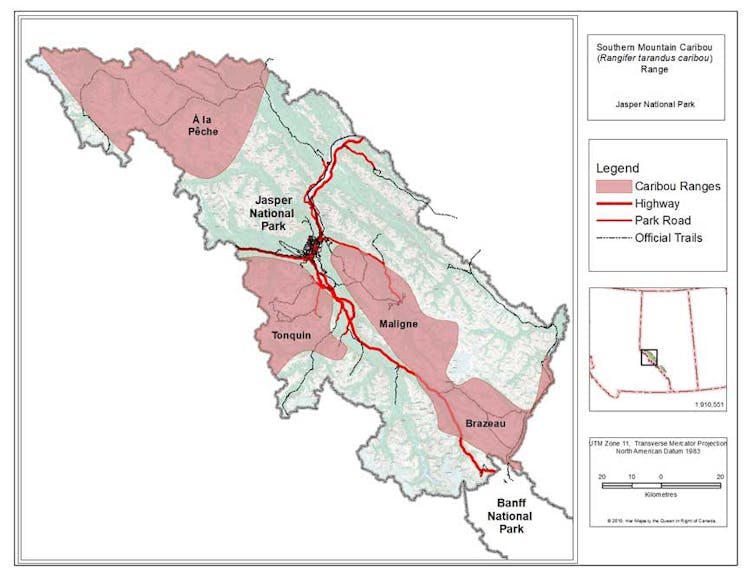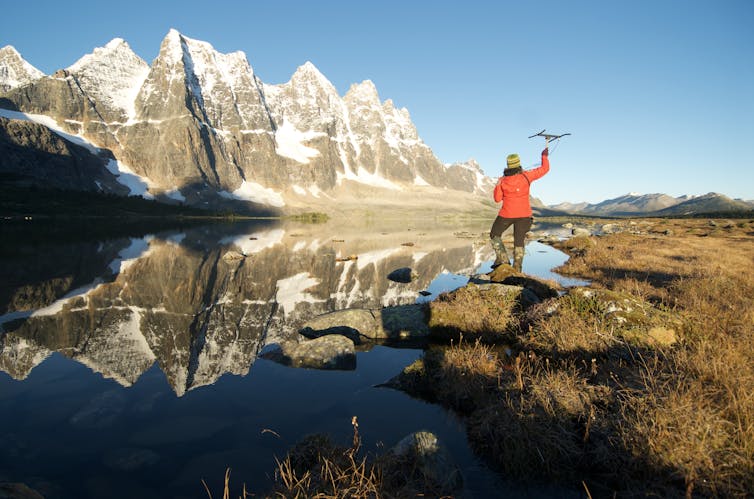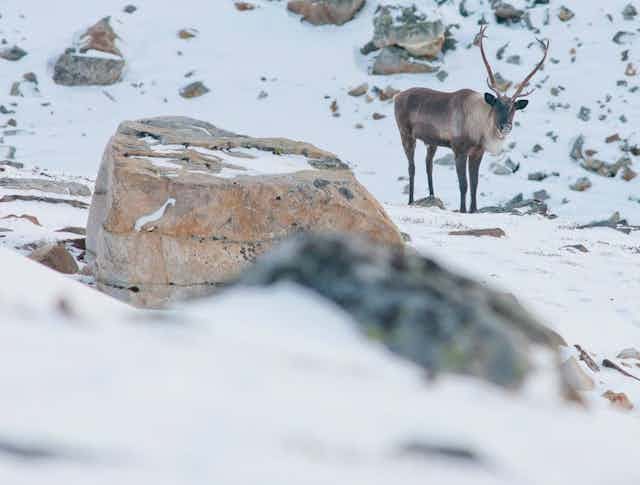In October, more than two years after the last caribou in the Maligne Valley of Jasper National Park died or disappeared, Parks Canada announced a tentative plan for a caribou captive breeding program. Subject to an expert review that will likely take place in January, females from other herds will be rounded up and penned in a facility near the town of Jasper.
Stan Boutin, a biologist from the University of Alberta, sees these desperate measures as necessary — and these are desperate times for caribou herds.
There are now only three herds in Jasper National Park. None of them are faring well. The 45 animals in the Tonquin herd are down by a third since 2010, the Brazeau herd is left with just 15 animals, and neither has enough females to grow the population. The last stronghold is the À la Pêche herd, with 150 caribou that move precariously in and out of the north end of the park.
Decades of planning
Parks Canada has been looking for ways to save the caribou in its mountain parks for decades. In 2002, it floated a plan to close the Maligne Road that takes vehicles up to the base of the caribou’s alpine winter range, so that it would be harder for wolves to access the dwindling herd.
But officials dropped the idea four days after the plan was made public and the business community complained. The caribou recovery plan never made it to the public consultation phase. The business community high-fived. Park biologists licked their wounds.

Scientists were hugely concerned that a large animal like caribou could disappear from a national park in Canada as the herd in Banff did in 2009. Writing in Conservation Biology, several noted that Banff National Park’s last southern mountain woodland caribou died the same day a coalition of conservation groups announced the Banff Spring’s snail was the “only species out of 449 listed under the Canadian Species at Risk Acts to benefit form the fully legally mandated conservation process.”
Federal legislation compels the government to protect species at risk, and in 2011, it launched a captive breeding program for southern mountain caribou with Parks Canada, the B.C. government and the Calgary Zoo. It was supposed to be a new beginning and the cornerstone of the caribou conservation strategy, but the agreement fell apart in 2015.
Science-based conservation programs in the mountain parks have long been pitted against tourism. Jasper’s resource conservation manager was fired in 2015 without cause, though many suspect that it was because he had pushed for the release of an overdue report on how a Jasper ski hill expansion would affect the threatened Tonquin caribou herd. His departure coincided with a plan to build overnight tourist accommodations in the Maligne Valley.
Decades of decline
It’s not just caribou in Jasper, Banff and other mountain national parks that have suffered. In the 1970s, Parks Canada dithered on stopping the serious decline of the woodland caribou in Pukaskwa National Park on the shores of Lake Superior.
There were only about 24 caribou then, and the population collapsed to just five individuals in 2009 and then disappeared entirely. Caribou might never have had a strong foothold in Pukaskwa, but the approach of doing nothing while watching the population’s extirpation wasn’t a plan either.

It’s not that Parks Canada is doing nothing about endangered species and wildlife recovery. Bison were reintroduced successfully into Banff recently, but bison can adapt to almost any ecosystem. To its credit, Parks Canada also proceeded with the difficult challenge of removing exotic trout from many of the mountain park lakes by poisoning them, which could have been a public relations nightmare.
Read more: Historical photo of mountain of bison skulls documents animals on the brink of extinction
Caribou are different. Like polar bears, they are climate-challenged animals. They need alpine space, buggy bogs and forested fens in order to escape predators, flee from wildfire and find the food they need to survive.
They’re having hard time doing that outside of national parks, where the peatlands in oil and gas developments, logging and coal mining sites are being carved up and eaten by roads, seismic lines and oilsands operations.
In 1992, naturalist Ben Gadd predicted caribou would disappear from Jasper if Parks Canada didn’t set aside two large exclusion zones to protect them. He and other members of the Jasper Environmental Association had the ear of park biologists back then, but not the support of Ottawa.
Senior officials have consistently bent to the will of those in the business community to expand ski hills and build roads and monuments, including the monstrous Mother Canada Monument in Cape Breton National Park, even when it violated the spirit of the National Parks Act.
Ministers rarely come to the rescue because few stay in the job for long. Since 1971, there have been 30 ministers in charge of Parks Canada. Just two lasted more than three years, and 16 held the job for less than or little more than a year.
Not enough caribou
In 2018, Catherine McKenna, the longest serving environment minister, realized Parks Canada had lost its way when she said it was time to send the agency back on a conservation course. With McKenna now serving as infrastructure minister, judges and environmental groups are trying to hold Parks Canada and the federal government accountable.
Read more: It's time to press the reset button on Canada's national parks
The caribou recovery program in Jasper is sorely needed, but it is likely too little, too late. There are just not enough caribou around to grow the herds.
It also suggests that it’s easier for the Canadian government to pen and rear caribou in captivity than it is to deal with the issues threatening them in the wild. And that’s a sad commentary on an agency whose “first priority” is to protect the “natural and cultural heritage of our special places and ensure that they remain healthy and whole.”
Prime Minister Justin Trudeau had nothing to say about ecological integrity in national parks when he handed Jonathan Wilkinson his mandate in overseeing Environment Canada and the Parks Canada agency. What’s needed is a national board of advisers with a compelling legal mandate that can hold Parks Canada’s feet to the fire and shield it from political interference. Business as usual will not be successful in this era of climate change.


